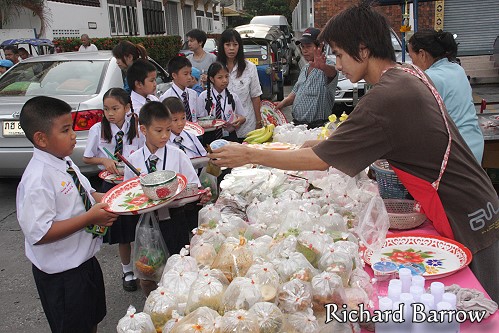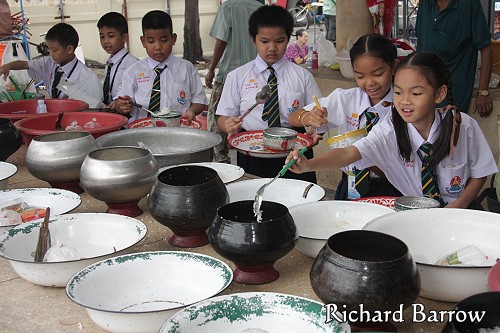Visiting a Thai Temple on Wan Phra

If you are a Christian, then you would know that your sabbath day is every Sunday. It is the day that you should go to church with your family. Buddhism also has a sabbath day called “wan phra” in Thai. You could translate this as “monk day” or maybe “holy day”. However, as Buddhism is based on the lunar calendar, you will find that “wan phra” is on different days of the week each time. The two most important days are the full moon and new moon. The other “wan phra” days are on the quarter phases of the moon. In all, there are 4 days a month when the monks don’t go out on their alms round and the local people go to the temple instead.

Obviously it is more convenient when “wan phra” falls on a weekend. But, a lot of people still go to their temple early in the morning before they go to work. I took these pictures this morning of students from my school. We arrived at the temple just before 7 a.m. To make proper merit you need to prepare the food specifically for the monks. You cannot use leftovers. These days people are so busy that you will find that at most temples there are stalls set up selling food for you to give to the monks. Once you have the food, you should crouch on the ground and raise the tray above your head in quiet contemplation.

On “wan phra” and some of Buddhist festival days, the monks are not lined up to receive alms. Instead, their alms bowls are placed on a long row of tables. People go along this line and place rice into each of the bowls. If they have Thai desserts or curries in plastic bags, they then put this in another bowl. It shouldn’t be mixed in with the rice. This food is then taken to the kitchen to be shared among the monks later in the morning. After the lay people have presented their offerings of food, they next paid homage to the Buddha image.

At about 7.30 a.m., earlier in other temples, a monk will ring the temple bell by beating it with a stick. This is the call to prayer. After the lay people have finished making merit, they make their way towards the community hall where all of the monks are already sitting on a low platform. We didn’t stay for this today as we had to go back to school. For about an hour, the monks take part in chanting. During this session, a senior monk also gives a sermon, and asks the lay people to recite the eight precepts. For normal Buddhists, there are only five precepts. However, on “wan phra” days, many Buddhists like to keep the eight precepts.

The eight precepts that they have to recite out loud are as follows:
“I undertake the training precepts…
(1) to abstain from taking life.
(2) to abstain from taking what is not given.
(3) to abstain from unchastity.
(4) to abstain from false speech.
(5) to abstain from intoxicants causing heedlessness.
(6) to abstain from untimely eating.
(7) to abstain from dancing, singing, music and unseemly shows, from wearing garlands, smartening with scents, and beautifying with perfumes.
(8) to abstain from the use of high and large luxurious couches.”
Novice monks and nuns have ten precepts. Monks have 227 precepts. They have to recite all 227 on the full and new moons every month.

